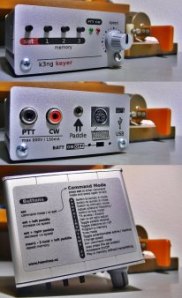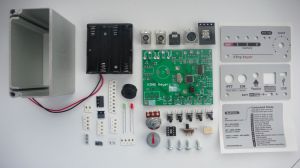Author Archive
 Review: Hamshop.cz Open Keyer
Review: Hamshop.cz Open Keyer

The Hamshop.cz Open Keyer is a cute little keyer kit that is Arduino based and runs my open source keyer software. It features a menu button, three memory buttons, a speed control, a PS2 keyboard connector, and a USB port. The unit can be powered either through the USB connector or an internal 3 AAA battery pack. A 1/8″ (3.5 mm) stereo jack is provided to connect your paddle and two phono connectors are for keying your transmitter key and PTT lines.
The brains inside the box is an Atmel ATMega chip running the Arduino bootloader, along with a USB chip. Essentially it’s an Arduino and the normal Arduino development IDE can talk to it and program it. As mentioned before it’s intended to run my open source keyer code, but it can be used with any Arduino code including your own keyer implementation. If you don’t need a PTT line for your transmitter, you can easily modify the source code to use the PTT port and a second transmitter keying port.
Most of the circuit is surface mount technology (SMT). I hadn’t soldered SMT components for several years. Last year I got my first set of reading glasses, and I found myself cursing the little parts, which in my more youthful years I’d have no problem working with. This is no fault of Hamshop, just me whining about my age. Luckily Hamshop pre-installs the ATMega and USB chips, so the most difficult components are taken care of for you. The enclosure is a very simple but effective extruded aluminum two-piece clamshell or channel with two end pieces for the front and back. Vinyl decals are provided for the front and back, and an instruction decal is provided for the top. (Although my callsign is on the front of the unit, note that I did not design the hardware or kit.)

The unit performs well, though I accidentally left it on battery power for a few days and totally drained the batteries. This prompted me to add a sleep mode feature to my code which is in beta testing and should solve this problem. One minor issue with the Open Keyer kit is the front speed knob. On my unit it does not fit well, with not enough of the potentiometer shaft exposed for the knob to grab on to. Ondra, OK1CDJ, at Hamshop tells me that they’re adjusting the alignment of the potentiometer in the next revision to address this problem.
I won’t review the actual keyer software as the documentation for this is here, and naturally I’m a bit biased about it, but it does about anything a CW aficionado would want to do. All in all the Hamshop Open Keyer is a nice little kit that can be assembled in an evening or two, and is reasonably priced.
(Full disclosure / disclaimer: I do not have a financial interest in Hamshop, and I can’t provide support for this keyer hardware. Support for the open source code is available on the Radio Artisan discussion group.)
 Obligatory New Years Post
Obligatory New Years Post
Greetings and Happy New Year! Our celebration last night was one that married 40-somethings with kids often have — a night spent at home watching Dick Clark’s New Years Rockin’ Eve.
On the amateur radio front, this past weekend I participated in the Stew Perry Challenge, a 160m all CW contest. I debated whether to go QRP or 100 watts and decided to go with 100 watts. Although I can’t brag about the amazing performance that QRP and a rather modest inverted L would have given, I certainly had as much if not more fun than last year’s event. I netted over 180 contacts in my casual operating effort, even bagging about six west coast stations. I think the Stew Perry Challenge is a cool little contest, perhaps underrated. Its uncommon exchange for an HF contest, grid squares, and its unique scoring that takes into account distance and worked station transmitter power makes for an interesting contest. I wrote in my notes for 2013 that I have make a serious effort and do all 14 hours in the test next year.
I can’t say I have any hardcore amateur radio News Years resolutions, other than “do what I like and like what I do”. I started following this mantra three years ago and it has served me well. I tend to avoid getting into rituals but one I do want to start after authoring one last year is getting at least one amateur radio article published each year in a mainstream magazine (i.e. QST or CQ). I also tend to avoid competition, but I want to “up my game” in the PA QSO Party and also make more than a casual effort in one of the big contests.
In the Radio Artisan lab there are two main projects in progress. I have a working prototype of the Arduino based balanced antenna tuner. It’s been a technically challenging project, but very interesting. I still need to improve the SWR sensor performance and develop some shortcuts in the tuning algorithm to lessen the tune time. The other project is learning KiCad, an open source EDA program for developing schematics and PC boards. In the next week or two I will publish a post on my experiences. It’s not perfect but it’s definitely a viable replacement for the venerable and popular Eagle program.
Here’s to a healthy and prosperous 2013. Work, eat, sleep, and play radio.












